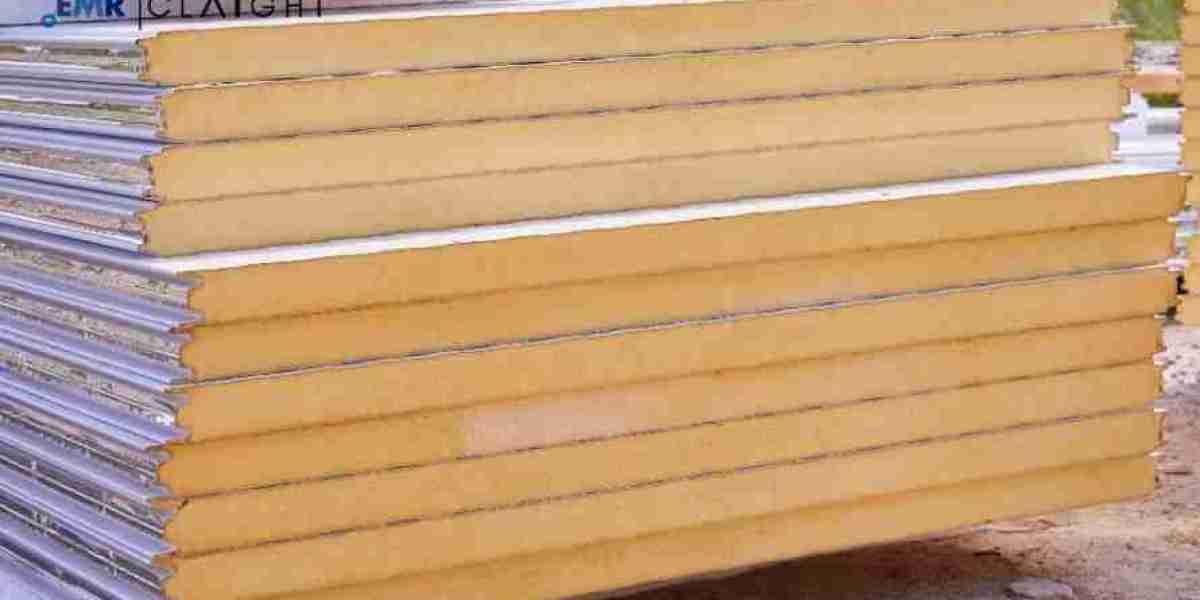In the evolving landscape of modern construction, efficiency, sustainability, and innovation stand at the forefront of development. As the demand for energy-efficient and high-performance building materials surges globally, sandwich panels have emerged as one of the most transformative solutions in the construction sector. These structural materials, composed of two thin layers of rigid material enclosing a lightweight core, are widely appreciated for their durability, thermal insulation, and ease of installation. The global sandwich panels market stood at a value of around USD 13.91 billion in 2024. The market is further expected to grow in the forecast period of 2025–2034 at a CAGR of 5.2% to reach USD 22.03 billion by 2034. This substantial growth reflects a growing interest from end-user industries such as construction, refrigeration, and automotive, spurred by rising urbanization and the need for sustainable solutions.
Sandwich panels are advanced construction materials used extensively in industrial, commercial, and residential infrastructure. A typical sandwich panel comprises three layers: an insulating core (such as polyurethane, polystyrene, mineral wool, or PIR) nestled between two metal sheets, often made from steel or aluminum. These materials are engineered to offer superior mechanical performance while reducing weight, making them ideal for prefabricated buildings and cold storage facilities.
The technology behind sandwich panels is not entirely new, but modern improvements in materials science have significantly enhanced their properties, enabling better insulation, fire resistance, and longevity. Their growing popularity is underpinned by a combination of environmental regulations, cost-efficiency, and demand for quick-to-install materials in urban areas facing construction time constraints.
Key Market Drivers
Several factors are propelling the sandwich panels market forward. Firstly, there is a surging demand for energy-efficient and thermally insulated materials across the construction and refrigeration sectors. Sandwich panels help maintain indoor temperatures, significantly reducing energy consumption in buildings. With energy efficiency regulations becoming more stringent in regions like Europe and North America, sandwich panels are increasingly favored by builders and architects.
Secondly, the rise in industrialization and infrastructure development across developing nations—especially in Asia-Pacific and the Middle East—is a major growth driver. These regions are witnessing a boom in logistics hubs, manufacturing facilities, and warehousing spaces, all of which require high-performance building envelopes. The lightweight and durable nature of sandwich panels makes them ideal for these applications.
Lastly, prefabricated construction is gaining traction globally due to labor shortages, project delays, and cost overruns in traditional building methods. Sandwich panels play a crucial role in modular and prefabricated buildings by offering flexibility, speed, and design adaptability.
Get a Free Sample Report with TOC
Material Insights
The core materials used in sandwich panels significantly influence their performance and application. The most commonly used core materials include:
Polyurethane (PU) and Polyisocyanurate (PIR): These are the most popular due to their excellent thermal insulation and light weight. They are widely used in cold storage and refrigerated transport.
Expanded Polystyrene (EPS): Known for affordability and ease of manufacturing, EPS panels are commonly used in residential and commercial building claddings.
Mineral Wool (Rock Wool): Highly fire-resistant, these panels are preferred in areas with strict fire safety regulations, such as industrial plants and chemical facilities.
The choice of core material depends largely on the end-use application, regulatory requirements, and climate conditions of the region where the panels are installed.
Applications Across Industries
Construction Sector
The construction industry is the largest consumer of sandwich panels. These panels are extensively used in walls, roofs, and facades of commercial buildings, industrial facilities, and institutional structures. Their advantages—such as quick installation, reduced structural load, and better insulation—are highly valued in modern construction. As green building practices gain momentum, sandwich panels are being integrated into designs for their energy-saving benefits.
Cold Chain and Refrigeration
Refrigeration units, including cold storage facilities, refrigerated trucks, and processing plants, rely heavily on sandwich panels for maintaining low temperatures. PU and PIR panels are especially popular in this sector for their superior thermal resistance. With the global cold chain market expanding due to the growth of perishable goods and pharmaceuticals, demand for sandwich panels in this sector is expected to grow steadily.
Automotive and Transportation
Though smaller in comparison, the transportation sector also uses sandwich panels in specialty vehicles like refrigerated vans and containers. Their use in trailers and bus bodies is rising due to benefits like lightweight and insulation.
Renewable Energy Projects
In solar farms and wind turbine manufacturing plants, sandwich panels are being adopted for equipment housing and service buildings. The renewable energy sector’s expansion supports further growth of sandwich panel applications.
Regional Market Analysis
Europe
Europe holds a significant share of the global sandwich panels market, driven by strict building energy codes, fire safety regulations, and a high emphasis on sustainability. Countries like Germany, France, and the United Kingdom are leading adopters, particularly in green building initiatives. The demand is also fueled by the refurbishment of old industrial buildings and the growing cold storage infrastructure.
Asia-Pacific
Asia-Pacific is the fastest-growing regional market, with China, India, and Southeast Asia at the forefront. Rapid urbanization, a growing middle-class population, and industrial expansion are driving demand for cost-effective and thermally efficient construction solutions. Moreover, government-led infrastructure development projects are significantly boosting the need for sandwich panels.
North America
In North America, growth is driven by the demand for prefab construction, cold chain expansion, and the need for sustainable building solutions. The U.S. is the primary contributor, with rising investments in commercial real estate, warehousing, and data centers.
Middle East and Africa
These regions are seeing rising adoption of sandwich panels due to climatic conditions that require efficient thermal insulation. Additionally, the construction boom in Gulf countries and urban development initiatives such as Saudi Arabia’s Vision 2030 are major contributors to the regional market.
Technological Advancements
Innovation in core and facing materials is reshaping the sandwich panels market. For instance, nanotechnology-enhanced cores are being developed for improved fire resistance and thermal performance. Manufacturers are also experimenting with sustainable materials such as bio-based polyurethane foams to reduce carbon footprints.
Digital manufacturing technologies like Computer Numerical Control (CNC) and Building Information Modeling (BIM) are also enabling precision manufacturing and better integration with smart building systems. These technologies help in reducing waste, optimizing designs, and enhancing lifecycle management.
Environmental and Regulatory Landscape
Environmental concerns have had a profound impact on the sandwich panels market. Regulatory frameworks across the world are increasingly focused on energy conservation and reducing greenhouse gas emissions from buildings. The European Union’s Energy Performance of Buildings Directive (EPBD) and the U.S. Department of Energy’s building codes have made it mandatory for new constructions to meet stringent thermal performance benchmarks.
In response, manufacturers are investing in R&D to develop panels that meet or exceed these standards. Additionally, the use of recyclable and reusable materials in sandwich panels aligns with circular economy principles, making them a more sustainable choice for future-ready buildings.
Competitive Landscape
The global sandwich panels market is moderately fragmented, with key players competing based on product quality, pricing, innovation, and customer service. Some of the major players include:
Kingspan Group
ArcelorMittal
Tata Steel
Rautaruukki Corporation (Ruukki)
Isopan
NCI Building Systems
Italpannelli
Assan Panel
These companies are focusing on expanding their product portfolios, geographic presence, and manufacturing capabilities. Strategic mergers, acquisitions, and collaborations are also common to consolidate market position and drive innovation.
Challenges in the Sandwich Panels Market
Despite the promising growth, the market faces several challenges:
Raw Material Price Volatility: Fluctuations in the prices of steel, aluminum, and core materials such as PU and PIR can affect profit margins and pricing strategies.
Environmental Concerns Regarding Foam Insulation: Some foam-based core materials have raised environmental and health concerns due to off-gassing or non-recyclability, although newer eco-friendly variants are emerging.
Lack of Awareness in Emerging Markets: In certain regions, limited knowledge about the benefits and applications of sandwich panels may hinder adoption.
Skilled Labor Shortage: Despite being easier to install, sandwich panels still require trained personnel, particularly in large-scale or complex installations.
Future Outlook
The future of the sandwich panels market looks promising, buoyed by trends such as green construction, smart buildings, and the rise of modular housing. With continued advancements in insulation technologies, material science, and digital design, sandwich panels are expected to play an increasingly critical role in addressing modern construction challenges.
In the next decade, we can anticipate a shift toward bio-based core materials and enhanced fire-resistant solutions to comply with evolving safety standards. Moreover, integration with IoT-enabled sensors may allow for real-time monitoring of thermal efficiency, structural integrity, and environmental performance.
Governments and international bodies are also likely to introduce more subsidies and incentives for energy-efficient building materials, further driving demand. As construction practices shift toward sustainability and circular economy principles, sandwich panels are set to become the gold standard for modern infrastructure development.
Media Contact
Company Name: Claight Corporation
Contact Person: Chander Deep, Corporate Sales Specialist
Email: sales@expertmarketresearch.com
Toll Free Number: +1–415–325–5166 | +44–702–402–5790
Address: 30 North Gould Street, Sheridan, WY 82801, USA
Website: www.expertmarketresearch.com








